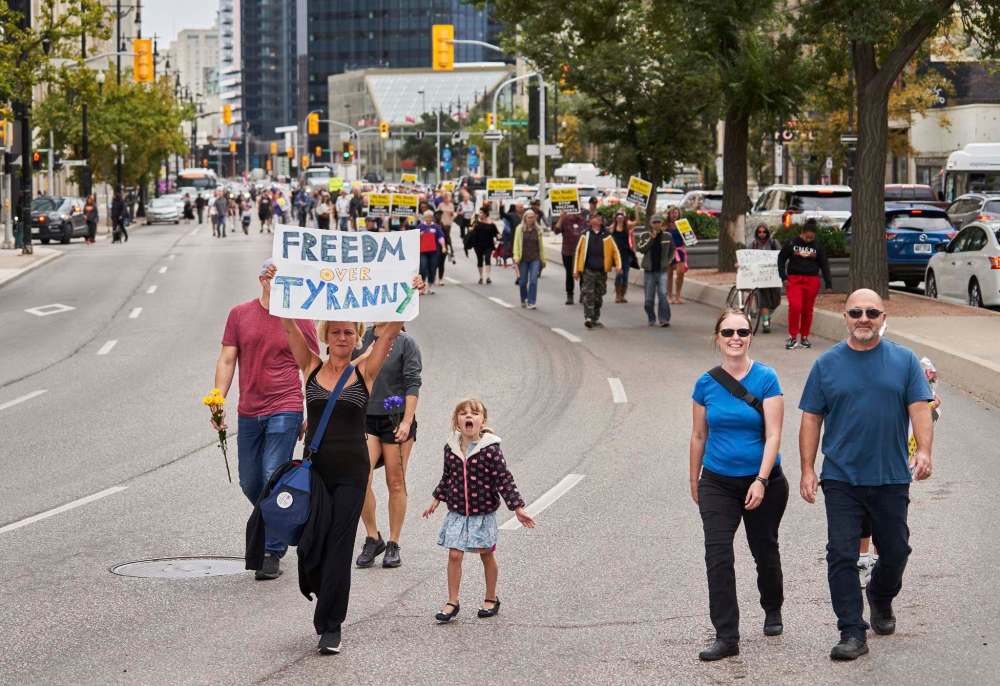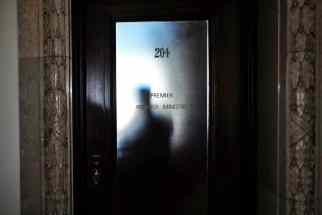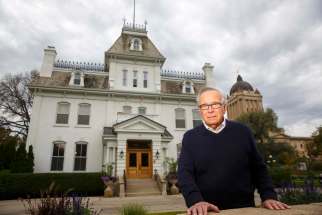Sadness amid the madness Anti-vax protests point out a tragic societal fracture that seems beyond mending
Read this article for free:
or
Already have an account? Log in here »
To continue reading, please subscribe:
Monthly Digital Subscription
$0 for the first 4 weeks*
- Enjoy unlimited reading on winnipegfreepress.com
- Read the E-Edition, our digital replica newspaper
- Access News Break, our award-winning app
- Play interactive puzzles
*No charge for 4 weeks then price increases to the regular rate of $19.00 plus GST every four weeks. Offer available to new and qualified returning subscribers only. Cancel any time.
Monthly Digital Subscription
$4.75/week*
- Enjoy unlimited reading on winnipegfreepress.com
- Read the E-Edition, our digital replica newspaper
- Access News Break, our award-winning app
- Play interactive puzzles
*Billed as $19 plus GST every four weeks. Cancel any time.
To continue reading, please subscribe:
Add Free Press access to your Brandon Sun subscription for only an additional
$1 for the first 4 weeks*
*Your next subscription payment will increase by $1.00 and you will be charged $16.99 plus GST for four weeks. After four weeks, your payment will increase to $23.99 plus GST every four weeks.
Read unlimited articles for free today:
or
Already have an account? Log in here »
Hey there, time traveller!
This article was published 17/09/2021 (1544 days ago), so information in it may no longer be current.
The protest’s location had changed, but evidently one family didn’t get the memo. The three of them arrived alone that afternoon, walking up Sherbrook Street towards the Health Sciences Centre’s main entrance. Two local news photographers trailed behind them; people leaving the hospital hustled past without interest.
The man held a picket sign at his waist, drooping low. The side with the message faced away from the street. “It’s my choice,” it read. “Live with it. I will.” A woman and girl walked beside him. The man paused to look down at his phone, then up at the mostly empty sidewalk again.
A reporter asked if he knew where the protest was supposed to be: it got moved to the Leg, he said. Then he left, perhaps to meet up with the rally that, by then, was amassing at the legislature and preparing to march to city hall. About 150 people turned out and it made little impact, other than slowing traffic.

In other cities, the second round of hospital protests still happened. They seemed somewhat deflated as compared to the first, which impeded ambulances and intimidated patients and staff. Or, as Toronto Star columnist Bruce Arthur put it, witnessing this week’s protest outside Toronto General Hospital: “I didn’t expect it to be so sad.”
That’s the word that first came to my mind too, watching that man with his sign wandering outside HSC. There was a pathos to the scene, one that evoked less anger than pity, less disgust than sadness. Imagine waking up that day ready to protest outside a hospital, only to find your family arriving alone, sign dangling from your hands.
Imagine what led you there. Imagine what vicious rhetoric you’ve consumed that would allow you to see a hospital entrance as an appropriate place to make your stand. In the solitude of that man and his family, I saw in the space around him a whole lot of frustrating questions, but in the moment it was mostly just very sad.
It could have been worse. A lot worse. Since the start of the pandemic, one of the animating factors in resistance to public health orders and, now, vaccines has been rage, the same combustible rage that drove far-right protesters to storm the U.S. Capitol in January. It’s driven by many of the same players. It shares the same characteristics.
On Twitter, one woman responded to a video of an Ontarian People’s Party of Canada candidate firing a rifle, and said the candidate should “bring that bad boy to tomorrow’s raid on Toronto General Hospital” because protesters would “get inside and show the world that COVID is fake.”
They didn’t go into the hospital. Yet while one shouldn’t put too much stock in the hot air a random person spews on Twitter, the naked aggression is alarming, and the threat has precedent. Last year, self-appointed “truth seekers” entered hospitals to “prove” the virus was a hoax; it’s entirely possible it will happen again.
When it does, the victims of this intrusion, this intimidation, will be hospital workers. They will be people without the power to shape the policies that protesters are so against, but who are asked to hold the line and save lives against those policies’ epidemiological effects. This is pure, and the majority of Canadians will not forget.
In Calgary this week, hospital staff affixed a sign in one window for protesters to see: “Go intubate yourself,” it read.

Is it too cynical to say that, when it comes to these clashes, there will not be a resolution? There cannot be, so long as the terms of debate cannot even be agreed upon. Those who protest at hospitals, and the large majority of Canadians who widely support vaccine mandates, are operating from positions that are far too fundamentally different.
Consider how, from the start of the pandemic, the specifics of resistance have been varied, and they have shifted. In the spring of 2020, COVID-19 was a “hoax,” caused by governments making a bid for control over something akin to the common cold; now it’s just as common to say it’s real, but with cures that doctors are concealing.
When the numbers show that hospitals are in crisis and vaccines are both safe and effective, they are dismissed as “manipulated.” Everyone on Facebook anti-vaccine groups knows a guy who knows a guy whose cousin is a nurse and swears ICUs are empty; when ICU nurses speak about what they’ve endured, that information is disregarded.
The short way to understand this dissonance is pretty simple: for the most part, we — yes, I include myself in this — tend to gravitate most to sources of information that confirm our own thinking; how we dissect news is part facts, and a whole lot based on feeling. We all cluster around information that confirms our priors.
In the case of vaccine mandates, as with many social debates in recent memory, that gap has fractured any chance of having a sober public discussion almost from the beginning. It happened so quickly, which is inevitable in a crisis, but the byproduct is that there has been little chance to consider them publicly in a methodical way.
It’s hard to see how we can do that, even now: the battle lines are so stark. In or out, with or against, yes or no.
Yet there are reasonable questions around the mandates. On one hand, it’s true we have to use every tool we have at slowing the spread of COVID-19, but it’s not unreasonable to be concerned about what those tools mean, or how they might be used or misused in the short or long term.
It doesn’t require conspiracy, for instance, to be concerned about a relatively sudden expansion of how governments can restrict access to social spaces based on medical status. And there has been relatively little public discussion of how the mandates could impact some of those who are already among the most socially vulnerable.
Sometimes I think about how many people who live without stable housing rely on coffee shops for a place to warm up in winter. Social service agencies have done much to help the folks they serve get vaccinated; still, I worry about who will be pushed even further to the margins, for lack of ID or proof of vaccination.
The problem is, none of those concerns can be given a fair hearing, when the loudest voices in opposition are tied up in threatening health-care workers, propagating conspiracy theories and potentially deadly misinformation, and thunderously insisting that the only relevant consideration is “personal choice.”
That’s the thing about a pandemic. It puts light on the error in the main ideological streak underpinning these most aggressive protests: the idea that anyone lives as an island, our choices not affecting others. A pandemic is a virus infecting society as one body; it requires the co-ordinated response of the whole body to fix it.
“It’s my choice,” the man’s sign said. “Live with it.” That’s exactly the problem: we already are. What’s sad is, he cannot see it.
melissa.martin@freepress.mb.ca
Our newsroom depends on a growing audience of readers to power our journalism. If you are not a paid reader, please consider becoming a subscriber.
Our newsroom depends on its audience of readers to power our journalism. Thank you for your support.









